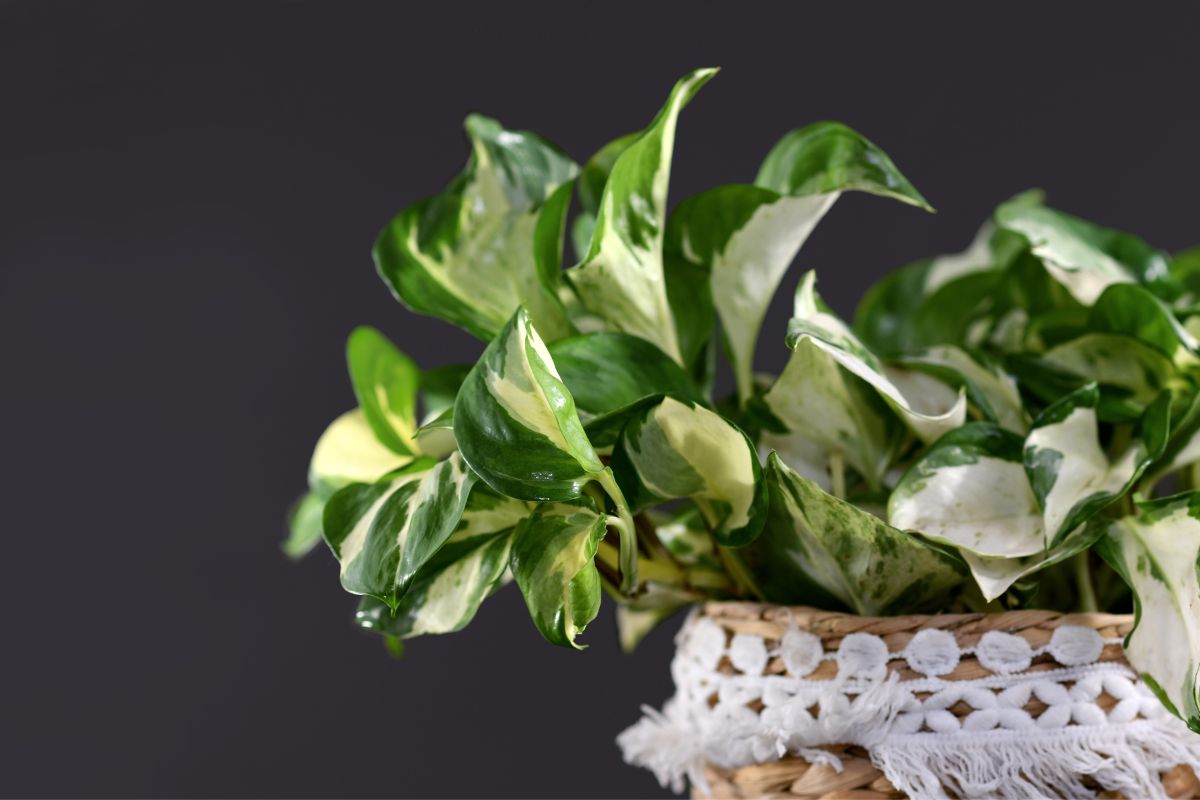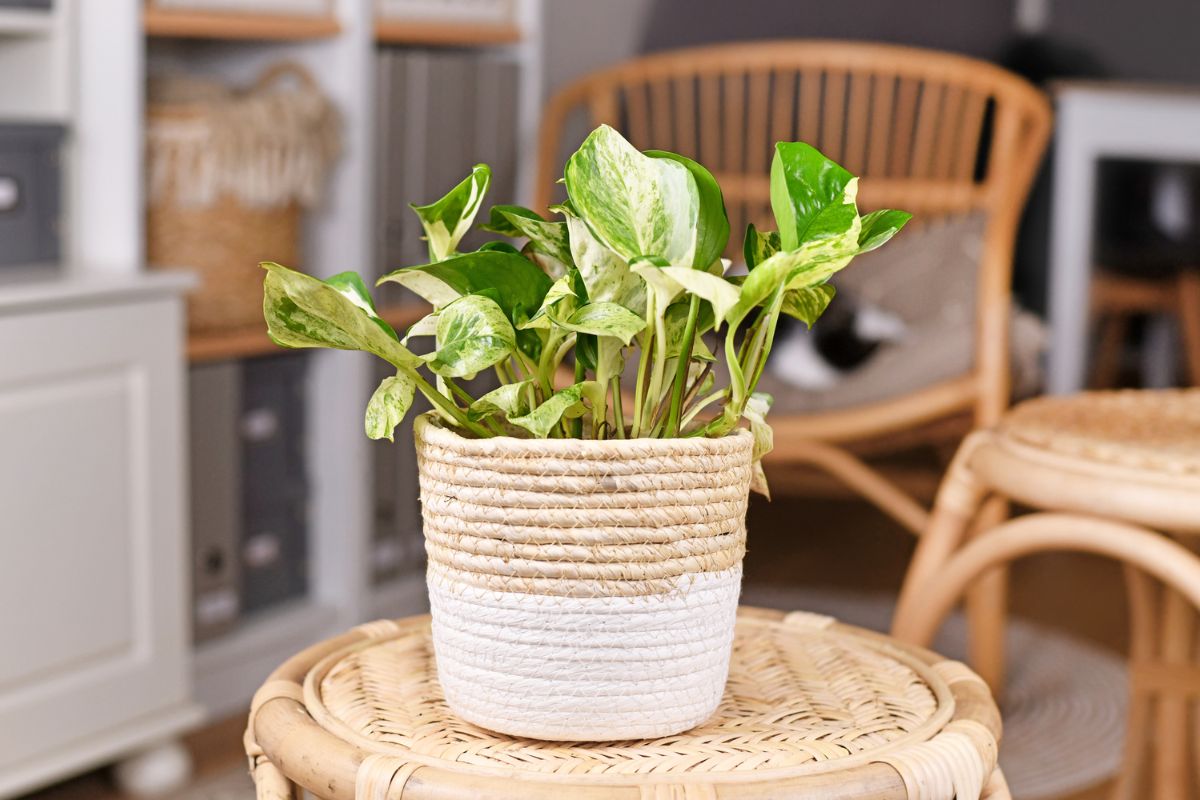The Harlequin Pothos is an exquisite tropical plant and is a great addition to any home or office, adding a touch of beauty and elegance wherever it goes. But this amazing plant isn’t just beautiful – it’s also incredibly easy to care for.

What Does A Harlequin Pothos Plant Look Like?
Harlequin pothos is a beautiful and exotic tropical plant. It has bright, glossy foliage with variegated leaves in shades of yellow, white, and green.
For example, the ‘Marble Queen’ variety features heart-shaped leaves with light green centers and yellow edges. The stems are also striking – they’re striped in white and green.
These plants can grow up to ten feet tall if they’re given enough space, but they’re easy to keep trimmed back to a more manageable size.
Some varieties of harlequin pothos have trailing vines that make them perfect for hanging baskets or climbing up trellises.
Care Of Harlequin Pothos Plant
Light
As the care of a harlequin pothos plant is vital for its health, so too is the importance of light. Harlequin pothos thrive in bright and indirect sunlight.
One could almost say that they even prefer it, as without light their beautiful variegated foliage would quickly fade.
To provide your harlequin pothos with the best possible growing conditions, place it near a bright window away from direct sun exposure.
Direct sunlight is far too harsh and can damage your plant’s delicate leaves; instead opt for a spot with plenty of indirect light or filtered sun. If you have trouble finding such a location in your home, artificial grow lights are an excellent alternative.
Soil
Harlequin pothos plants require soil that is well-draining yet holds moisture. A high quality potting soil should be used, or you can make your own using a combination of perlite, peat moss and vermiculite.
If using a store bought soil, it should not contain any slow release fertilizers, as harlequin pothos are sensitive to too much fertilizer.
When transplanting the plant or repotting, always use fresh soil and avoid disturbing the roots too much.
The best time to repot is in spring before new growth appears, however if the plant outgrows its pot sooner than this then it can be done at any time.
Harlequin pothos do not like overly wet soils, so ensure that water does not pool around the base of the plant for extended periods of time.
The soil should remain moist but never soggy; water when the top few inches of soil start to dry out and empty excess from the saucer after each watering.
Humidity
Harlequin Pothos thrive in humid conditions. They require high levels of moisture to grow healthy and strong. To ensure their growth, the humidity levels in the room should be kept between 60-80%.
This can be achieved by misting the leaves with water daily or placing a humidifier nearby. Additionally, pebble trays filled with water and placed under the plant pot can help maintain proper humidity levels.
It’s important to monitor the humidity levels regularly, as too much or too little humidity can cause stress on the plant.
If you notice that the leaves start to turn yellow or brown, this could indicate that it is time to increase the humidity around your Harlequin Pothos.
On the other hand, if there are spots or wilting of leaves, this could mean that there is too much humidity present.

Temperature
Temperatures for the Harlequin Pothos are best kept between 60-75 degrees Fahrenheit, though it can tolerate lower temperatures for short periods of time.
To maintain these temperatures, try to keep the plant in a spot that does not get direct sunlight and away from any sources of extreme heat or cold.
Additionally, avoid placing your pothos near air conditioning vents or radiators since this could cause drastic temperature fluctuations.
Pruning
Pruning is an essential part of keeping your harlequin pothos healthy and thriving. It helps promote new growth, control the size of the plant, and remove diseased or dead leaves.
So how do you prune a harlequin pothos? First, always use sharp, clean pruning shears to prevent tearing or damaging the plant. Then look for any yellowing or dead leaves and snip them off at their base.
If the leaves are too big for your scissors, use your fingers to carefully tear them off. You can also trim back any vines that have grown outside their container, but be careful not to over-trim; this can cause damage to the plant’s main stem.
Pruning should be done regularly – once every month or two – to keep your harlequin pothos looking neat and healthy.
Fertilizer
The lush, heart-shaped leaves of the harlequin pothos plant are a sight to behold.
Their vibrant green color and intricate patterns make them a stunning addition to any home decor. But in order for your harlequin pothos to thrive, it needs the right fertilizer.
Fertilizer helps provide the essential nutrients that plants require for growth and development. Choosing the right kind of fertilizer is essential for ensuring that your harlequin pothos gets all the nutrients it requires for optimal health.
There are many types of fertilizers available on the market today, so be sure to do some research before you purchase one.
When applying fertilizer to your harlequin pothos, make sure to follow the instructions on the product label carefully. Over Fertilizing can be detrimental to your plant’s health, so it is important to use only as much as is recommended.
Water
It’s essential to find the right balance between too little and too much water, as both can be damaging.
The best way to water your harlequin pothos is to wait until the topsoil is dry before watering again. You should also make sure you use clean, filtered or distilled water, as tap water can contain chemicals that are harmful to plants.
It’s also important to make sure your harlequin pothos have proper drainage so that excess water doesn’t build up in the pot and cause root rot.
Make sure there are drain holes in the bottom of the pot and place a layer of gravel or stones at the bottom before adding soil. This will help ensure any extra moisture will escape through those holes rather than pooling in the pot.
Diseases
Harlequin pothos plants are generally quite hardy and rarely get diseases. However, there are a few common issues you should be aware of:
- Potting mix that is too wet, leading to root rot.
- Insect infestations such as mealybugs.
- Fungal diseases such as powdery mildew or leaf spot.
Taking steps to prevent problems from occurring in the first place is the best way to ensure a healthy plant. Make sure your potting soil has good drainage and avoid overwatering. Monitor for pests regularly and treat them promptly if necessary.
Finally, fertilize only when the plant needs it; too much fertilizer can cause an imbalance of nutrients in the soil that can lead to disease.
Conclusion
The Harlequin Pothos is a stunning, exotic looking houseplant that can liven up any room in the home.
With its bold coloration and vibrant foliage, it’s sure to be a showstopper! All this beauty requires is some careful attention and proper care to ensure it thrives.
- Interesting Flowers That Start With A - July 21, 2023
- Interesting Flowers Beginning With H - July 21, 2023
- 14 Fascinating Flowers That Begin With C - July 20, 2023
